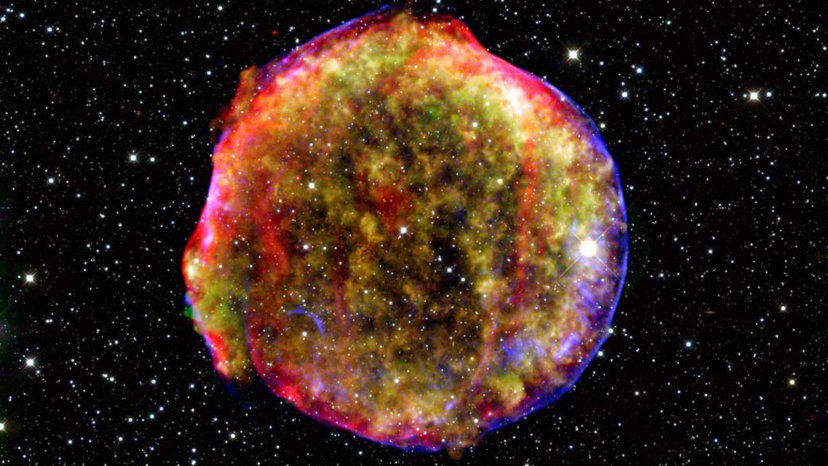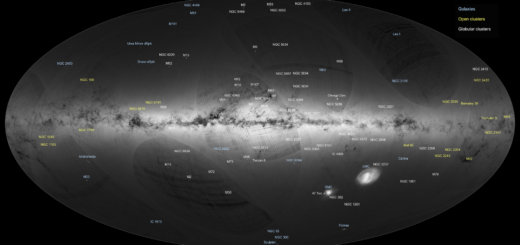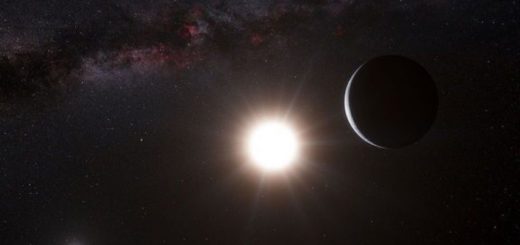The Monster Star That Refuses to Die: Could Antimatter Be Fueling Its Supernovas?

The idea behind the death of a massive star is relatively straightforward: It gets old, runs out of fuel, collapses under gravity and then explodes as a supernova. After the supernova, all that remains of the once magnificent star is a black hole or neutron star and a turbulent cloud of newly formed heavy elements.
But there’s a star in a distant galaxy that is refusing to fade gently into the night after an explosive death. In fact, it’s exploded again and again – a conundrum that’s puzzling astronomers.
In 2014, the Palomar Transient Factory (located at Palomar Observatory, near San Diego, California) detected a supernova over 500 million light-years away. Named “iPTF14hls,” the event appeared to be a regular supernova, but during follow-up observations of the region, astronomers realized it was anything but. The star that had apparently exploded wasn’t dimming, as would normally be expected after a massive star is blown to smithereens. Instead, it was mysteriously brightening after it had initially started to dim.
It’s as if the star has been acting like a “trick candle” on a kid’s birthday cake; after being blown out, it sparks back to life, continuing to burn as if nothing happened.
Astronomers describe their investigation into this stellar oddity in a study published in the journal Nature. While poring over historical observations of the star, they also made another striking discovery: This star hasn’t survived one supernova; it appears to have also survived a supernova that occurred over half a century before, in 1954!
“This supernova breaks everything we thought we knew about how they work,” said Iair Arcavi, a NASA Einstein postdoctoral fellow at Las Cumbres Observatory (LCO) and the University of California Santa Barbara. “It’s the biggest puzzle I’ve encountered in almost a decade of studying stellar explosions.”
Using the twin telescopes of the Keck Observatory on Maunakea, Hawaii, the researchers were able to gather spectroscopic data from the afterglow of the supernova and observations of its host galaxy to better understand what might be driving this oddity. The study calculates that the star may be more than 50 times the mass of our sun — a true stellar monster — and the 2014 supernova could be one of the most powerful explosive events ever recorded. The sheer power of this explosion, the researchers say, could reveal the origin of the star’s unwillingness to die, and it could be the first example of a “Pulsational Pair Instability Supernova.”
“According to this theory, it is possible that this was the result of star so massive and hot that it generated antimatter in its core,” said Daniel Kasen, who works at the University of California, Berkeley and Lawrence Berkeley Lab, in a statement. “That would cause the star to go violently unstable, and undergo repeated bright eruptions over periods of years.”
However, such explosions are theorized for massive stars that lived in the early universe, so this is akin to finding a dinosaur alive today, the researchers said. And that’s strange.
“If you found [a dinosaur], you would question whether it truly was a dinosaur,” said Andy Howell, leader of the LCO supernova group and co-author of the study.
Indeed, the Pulsational Pair Instability hypothesis doesn’t fully explain the nature of iPTF14hls as much more energy was released during the explosion than theory can explain. So now the researchers hope to seek out more of these repeating supernovas to see if antimatter really is the root cause or if there’s something else entirely behind the existence of these undead exploding stars.



 Creators of mankind
Creators of mankind Description of “Tall white aliens”
Description of “Tall white aliens” Where they came from?
Where they came from? About hostile civilizations
About hostile civilizations The war for the Earth
The war for the Earth “Tall white aliens” about eternal life
“Tall white aliens” about eternal life Video: “Nordic aliens”
Video: “Nordic aliens” Aliens
Aliens Alien encounters
Alien encounters The aliens base
The aliens base UFO
UFO Technology UFO
Technology UFO Underground civilization
Underground civilization Ancient alien artifacts
Ancient alien artifacts Military and UFO
Military and UFO Mysteries and hypotheses
Mysteries and hypotheses Scientific facts
Scientific facts


















